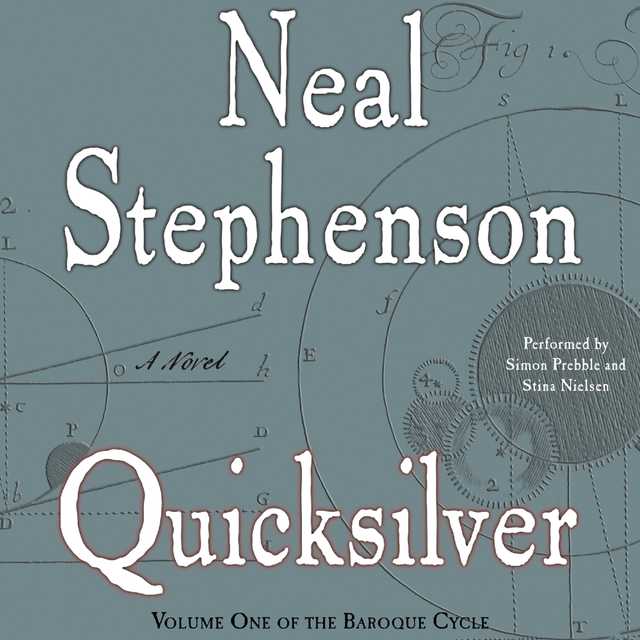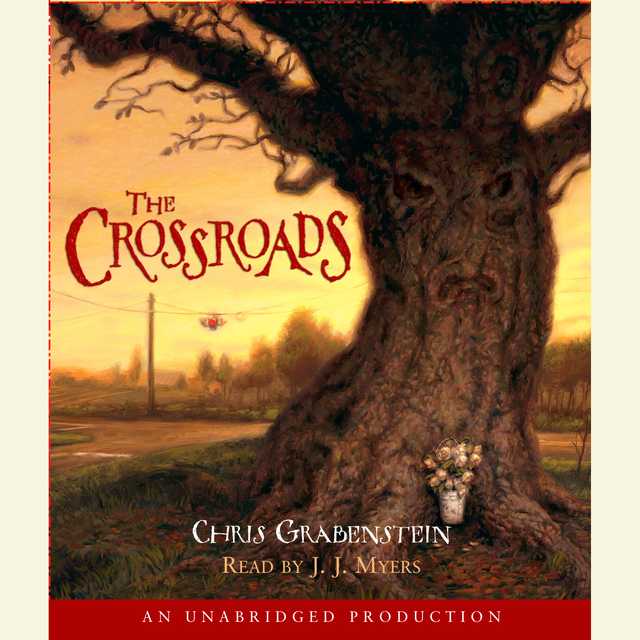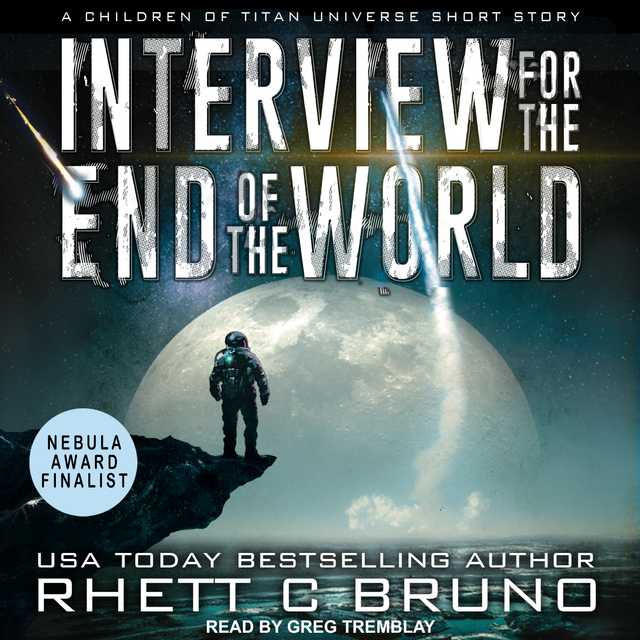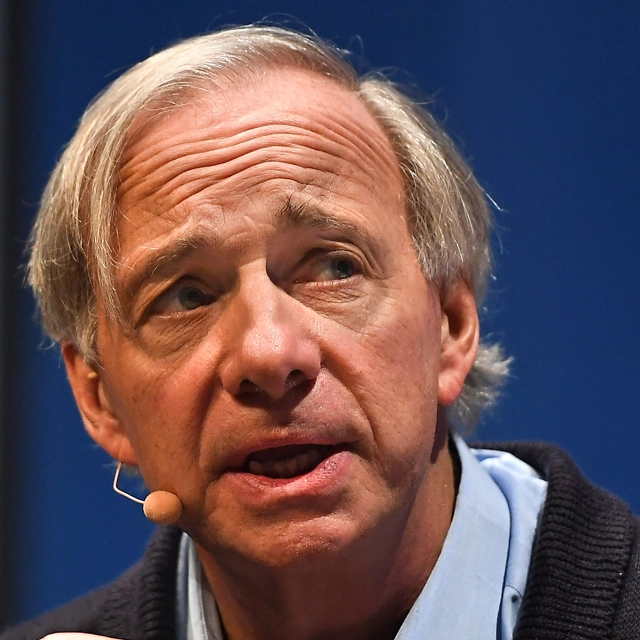Quicksilver Audiobook Summary
Quicksilver is the story of Daniel Waterhouse, fearless thinker and conflicted Puritan, pursuing knowledge in the company of the greatest minds of Baroque-era Europe, in a chaotic world where reason wars with the bloody ambitions of the mighty, and where catastrophe, natural or otherwise, can alter the political landscape overnight.
It is a chronicle of the breathtaking exploits of “Half-Cocked Jack” Shaftoe — London street urchin turned swashbuckling adventurer and legendary King of the Vagabonds — risking life and limb for fortune and love while slowly maddening from the pox.
And it is the tale of Eliza, rescued by Jack from a Turkish harem to become spy, confidante, and pawn of royals in order to reinvent Europe through the newborn power of finance.
A gloriously rich, entertaining, and endlessly inventive novel that brings a remarkable age and its momentous events to vivid life, Quicksilver is an extraordinary achievement from one of the most original and important literary talents of our time.
And it’s just the beginning …
Performed by Simon Prebble and Stina Nielsen
Other Top Audiobooks
Quicksilver Audiobook Narrator
Simon Preble is the narrator of Quicksilver audiobook that was written by Neal Stephenson
Neal Stephenson is the bestselling author of the novels Reamde, Anathem, The System of the World, The Confusion, Quicksilver, Cryptonomicon, The Diamond Age, Snow Crash, and Zodiac, and the groundbreaking nonfiction work In the Beginning . . . Was the Command Line. He lives in Seattle, Washington.
About the Author(s) of Quicksilver
Neal Stephenson is the author of Quicksilver
More From the Same
- Author : Neal Stephenson
- Some Remarks
- Termination Shock
- The Rise and Fall of D.O.D.O.
- Publisher : HarperAudio
- Abraham
- American Gods [TV Tie-In]
- Dead Ringer
- House of Sand and Fog
- Prey
Quicksilver Full Details
| Narrator | Simon Preble |
| Length | 22 hours 0 minutes |
| Author | Neal Stephenson |
| Category | |
| Publisher | HarperAudio |
| Release date | November 02, 2004 |
| ISBN | 9780060798055 |
Subjects
The publisher of the Quicksilver is HarperAudio. includes the following subjects: The BISAC Subject Code is Fiction, Historical
Additional info
The publisher of the Quicksilver is HarperAudio. The imprint is HarperAudio. It is supplied by HarperAudio. The ISBN-13 is 9780060798055.
Global Availability
This book is only available in the United States.
Goodreads Reviews
Kemper
July 30, 2011
(The following is an excerpt from the journal of Neal Stephenson.)After the success of Cryptonomicon, I’m having some problems narrowing down my next project. The issue is that I have far too many ideas, and I can’t decide which plot to use for my next book.I know that I want do something set during the late 17th century in Europe. It was an amazing time with huge changes in politics, culture, commerce and science, but there was just so much going on that I can’t seem to make up my mind and pick one or two concepts for the book. Here are some of the top ideas I’m mulling over:• The soldier and scientist dynamic between Waterhouse and Shaftoe worked so well in Cryptonomicon that I’d like to do something similar here. Perhaps have characters who are the ancestors of Lawrence Waterhouse and Bobby Shaftoe? • This would be during the early period of the Royal Society when men like Isaac Newton, Robert Hooke, Gottfried Leibniz, and many others were essentially creating modern science and battling among themselves. Putting an ancestor of Waterhouse in among them seems like a natural fit.• I’m also fascinated by all the religious upheaval in England following Cromwell’s death through The Glorious Revolution. Having a character with a Puritan upbringing caught up in these events would be interesting. Maybe that’s the place to bring a Waterhouse into it?• But I’m equally interested by all that was happening in commerce during this time. Our modern economic systems were being developed, and even the very nature of money itself was being redefined. I’d very much like to do a plot that involved that.• However, I’m also intrigued by all the political machinations and palace intrigue that took place across all of Europe.• If I do something with the political side, then I’ll almost certainly need to set something among all the wars and conflicts that took place. That might be a natural place to use a Shaftoe character.• I’d really like to dig into the details of how dirty, smelly, nasty and short life was to most people back then.• It might be more original to get away from the known events and famous people of the time and show a viewpoint from someone common like a vagabond. (Maybe this should be a Shaftoe character.)• Thinking about vagabonds, it’d be interesting to do a modern take of a picaresque novel with a rogue-ish hero getting into adventures and insulting the people of quality. This would definitely be a great Shaftoe character.• I’d also like to explore the role of women in this society. Maybe have some kind of very smart female character who has to use her charm and brains to navigate a variety of social and political challenges? Could I tie that in with the money thing?• Doing some kind of story about spies would be really cool. If I write about spies, I could use some of the cryptography stuff I brought into the last book again.• Pirates. I definitely need to do something with pirates.• Slavery. I should also work in some stuff about slavery.• I’d also like to use the Enoch Root character again. That’d really establish him as an ageless stranger who is kind of pushing events in certain directions, just like he did in Cryptonomicon. Plus, that gives it a bit of a sci-fi element so I’ll be eligible for all the Locus and Hugo-type awards.• On top of everything else, I’m dying to play with the format a little. Maybe do some chapters like a stage play from the era? Or tell a section via a series of letters? If I use letters to tell the story, it’d be another chance to work in the code stuff.There are too many possibilities. I don’t know how I’ll ever …. Wait. I just had a crazy thought. I shouldn’t be trying to NARROW the focus. I should EXPAND the focus. Throw all of these ideas and even more into one giant stew pot.No, that’s insane. It’d be too complex and convoluted. How could readers keep everything straight? Just trying to keep track of the various royal families alone would drive most people mad. I guess if I used just two or three main characters, but then had them shift into a variety of roles??? Waterhouse as a Puritan, a scientist, and a political player in England? Shaftoe as a soldier, a vagabond and a syphilis sufferer? (Maybe add another Shaftoe if one is going to have syphilis.) Make the woman a spy, an anti-slavery advocate, and a natural genius with money? Could it work? Have them all bounce against all the people and events of the time? How could I make that coherent? And it’d have to be huge. Probably at least three books with 800 to 900 pages a book. Yes. Yes! I can make it work! I am just that damn good. Those who go along with it will marvel at my genius. Those who can’t follow along will be too exhausted to complain. It’s brilliant. Those fools won’t know what hit them!And I will call it…. The Baroque Cycle. BWAH-HA-HA-HA-HA-HA!!! (Yes, I, Neal Stephenson, like to write evil laughter into my journal while I’m plotting my books.)Kemper’s Random Comments on Quicksilver• Wikipedia is your friend while reading this book.• Jack Shaftoe is not called ‘Half-Cocked Jack’ just due to his tendency to act without thinking. *shudder* • Isaac Newton should not have been allowed to handle needles.• Considering the way that various dogs, cats, horses, rats, frogs and ostriches are treated, this story is obviously set long before the ASPCA or PETA existed.• Stephenson has a lot of fun allowing his characters to make history. Daniel Waterhouse casually comes up with the name New York when others are debating what to call New Amsterdam after it changes hands. Eliza invents the word ‘sabotage’. Young Jack and his brother Bob create modern advertising and an early form of infomercial while making up small plays to advertise for their service helping condemned men hang faster and suffer less by dangling from their legs.•Venice gondoliers suffered from ‘canal rage’ caused by the hectic fast paced modern lifestyle they lived in.• After reading of the various ‘medical treatments’ used in here, you will hug your doctor the next time you go in for a check-up, and you will also feel the urge to call your dentist for a cleaning.• Jack considers it quite an accomplishment to have lived to the ripe old age of 20, and tells 19 year-old Eliza that she’s got a good ten or twenty years left to her.• European royal families were kind of gross.• I loved that Stephenson brings back his fictional country of Qwghlm, a godforsaken island under British rule where ice storms in June are common, and the English cut down all the trees.• Who knew that you could outwit pirates with math?• The scenes of trying to buy something are always hilarious because of all the haggling, not over the prices, but over what type of coins will be accepted because most are worthless due to the lack of reliable currency.• Why did I find it so funny that the English characters call syphilis the ‘French Pox’ and the French characters call it the ‘English Pox’?
WK
January 23, 2009
4.0/4.0It's the Moby-Dick question.The plot's about an angry guy chasing a whale. There's not a lot of variation on this theme: he catches it, or he doesn't. Maybe he catches it and wishes that he didn't, maybe he doesn't and regrets that he failed. But this basic plot, a straightforward quest for revenge, is such thin gruel that you'd have to be on the lower end of the intellectual spectrum to fail to realize that the book's about something a little bit more than hunting a big fish.Even so, there's no guarantee that you're going to tolerate 20 pages about rope. At the end of the digression, you're either going to respond in one of two ways. You might be of the sort to go, "Hmm, that was some fascinating rope discourse. I had no idea that rope could be used in such multifaceted ways, and having read that, I am now a different and slightly more rounded person." Then again, you could respond with a "JESUS FUCKING CHRIST, enough with the stupid rope already! For fuck's sake, where's that son of a bitch whale? The white sea mammal is the TITLE of the book, and I'm reading about some shitty rope?! Christ, I need some vodka."You should know what sort of reader you are before picking this book up, because The Baroque Cycle is about 3,000 pages long, and Neal Stephenson digresses like an ADHD kid on speed. Melville's focus is a goddamn space laser in comparison. Quicksilver has economics, mining, mathematics, piracy, slavery, early Puritan philosophy and I forget what else.It is genius, pure and simple.This is one of the first great works of the 21st century, and I can't recommend it highly enough. But odds are great that you'll hate it mightily if your concern is the destination instead of how you get there.
Markus
February 20, 2017
Quicksilver by Neal Stephenson is in some ways the strangest book I’ve read this year.The most surprising aspect of the book is the fact that there is no plot. I’ve read books that have started really slowly, and even books where the author largely ignores plot to focus on building the setting. This book, however, has no plot.For all intents and purposes, Quicksilver is The 17th Century: The Novel. In many ways it feels like the literary equivalent of an open world video game. You just go around exploring with the characters, with no context or coherence whatsoever. Historical value is incredible. Certain individuals, like Isaac Newton, John Churchill and William of Orange, figure heavily. Tons of others make shorter appearances. As for location, the book takes you everywhere from the port of colonial Boston to the 1683 siege of Vienna.And almost surprisingly, it’s charming. Almost a thousand pages of exploring a historical setting occasionally becomes an arduous task, but occasionally also becomes an exciting adventure filled with interesting details.The book is divided into three parts. Considering the ridiculous size of the whole volume, you might define the three as books in themselves. I definitely had to take a break and read other things between each of them.The first book focuses on Daniel Waterhouse, Puritan thinker and scientist and one-time member of the Royal Society. His part is split in two between a “present day” (1713) account of his leaving Massachusetts on a ship bound for England. This acts as a frame story for the second, which is a tale about his life and exploits with the Royal Society decades earlier. I strangely enjoyed the former more than the latter, even though it is moving so slowly that although the book starts out in Boston, the ship ends the part by sailing out of Massachusetts Bay.The second book focuses on Jack Shaftoe, vagabond turned mercenary, and Eliza, slave in the harem of the Ottoman sultan. From their meeting during the siege of Vienna, the book follows them on a journey together through the various principalities and kingdoms of Europe, filled with strange details and interesting histories.The third book pulls the first two together in something of a conclusion, leading up to the year 1688. The (historical) ending of the book was rather obvious if you are familiar with these times.Overall, it’s a much more interesting book to read in than a book to read. While there is little sign of a story, and the fictional protagonists are not particularly outstanding, the setting is uniquely interesting and very well described. Despite being a work of historical fiction, the reader will inevitably learn a lot about 17th century history, in very enjoyable ways.
Darwin8u
July 01, 2018
The gold that paid for a pound of Malabar pepper was melted and fused with the gold that paid for a boatload of North Sea herring, and all of it was simply gold, bearing no trace or smell of the fish or the spice that had fetched it. In the case of Cœlestial Dynamics, the gold—the universal medium of exchange, to which everything was reduced—was force.- Neal Stephenson, Quicksilver Book 1: QuicksilverThat one man sickens and dies, while another flourishes, are characters in the cryptic message that philosophers seek to decode.- Neal Stephenson, QuicksilverBook 1: Quicksilver gives off a bit of a low-brow SF Pynchon vibe. It works well in parts, and falls a bit flat in parts (dialogue, etc). I sometimes wish Stephenson wouldn't chase down every last snowflake. I really do, however, enjoy the primary narrator Daniel Waterhouse and his interactions with such figures as Isaac Newton, Samuel Pepys, John Wilkins, etc. Having already read Cryptonomicon, I was also glad to see Enoch Root (one of my favorite characters from that book). Like Pynchon, Stephenson takes historical fiction and probes the fiction needle into history at funky angles. He thrills at causing his fictional characters to interact in oblique ways to historical characters. Given the large amount of negative space in history (think about how much we DON'T know about people like Newton, or even the consumate diariest Pepys), a creative writer of historical fiction can bend/reflect/refract the light of the past to tell many compelling stories King of the Vagabonds(and they don't even have to be plausable, they just can't completely contradict major historical events).Book 2: King of the Vagabonds"Jack had been presented with the opportunity to be stupid in some, way that was much more interesting than being shrewed would've been. These moments seemed to come to Jack every few days."- Neal Stephenson, King of the VagabondsStephenson continues his Quicksilver Volume with Book 2: King of the Vagabonds. Where Book 1: Quicksilver dealt primarily with Isaac Newton and Daniel Waterhouse, King of the Vagabonds centers around the adventures of "Half-Cocked" Jack Shaftoe*, Doctor Leibniz, and Eliza. It seems to have taken stock of Joseph de la Vega's .'Confusion de Confusiones (1688), and perhaps also Charles Mackay's later Extraordinary Popular Delusions and the Madness of Crowds, and even Frances and Joseph Gies' Life in a Medieval City. Much of the book involves the adventures of two or three of the above Jack, Liebniz, Eliza making their way across many of the markets and cities of Europe. It allows Stephenson to discuss not only the politics of the age of Louis XIV, but also the changing markets (Leipzig, Paris, London, Amsterdam), politics, religion, and birth of the Age of Resaon. Stephenson has said in Book 1 he was primarily dealing with nobility and the top-end of the economic ladder. So, in Book 2 he wanted to spend a bit of time at the bottom of the ladder (hence Vagabonds).* "Half-Cocked" Jack Shaftoe, Daniel Waterhouse, and Eliza (of Qwghlm) are all ancestors of characters from Stephenson earlier book, Cryptonomicon. Enoch Root appears in this book as well as in Quicksilver AND Cryptonomicon. He is like a Zelig for science. Always appearing just where he needs to be to give the wheel a turn, the cart a push, the clock of progress a wind.Book 3: Odalisque"Even a well-made clock drifts, and must be re-set from time to time."- Neal Stephenson, OdalisqueAn odalisque was a chambermaid or a female attendant in a Turkish haram (seraglio), particularly the ladies in haram of the Ottoman sultan. So, the book title references Eliza, who in book 2: King of the Vagabonds is rescued by "Half-Cock" Jack (King of the Vagabonds). Eliza in this book enters the world of European economics and spycraft. She rises from broker of the French nobility, eventually earning the title of Countess of Zeur. She also aids William of Orange as he prepares to invade England, gaining the added title of Duchess of Qqghlm. Odalisque also brings us back to Daniel Waterhouse.I personally missed Jack Shaftoe, but that was partially assisted because we were introduced to his brother Bob Shaftoe.I've enjoyed Volume one. I'm a big fan of the Age of Enlightenment and was thrilled to experience of fictionalized Pepys, Newton, Leibniz, William of Orange, etc.***Negatives of the book(s), and series, so far? Like in Cryptonomicon Stephenson is going big (think Pynchon, Eco, etc), but his prose is flat often and his dialogue is worse. The dialogue seems closer to a Boston pub in 1987 than in a Royal Society meeting, but meh. It was still intersting and fascinating. I like the label: History of Science Fiction. So, I might not read this one twice, but I'll for sure finish the series - just not tonight.
Phil
September 27, 2021
Stephenson serves up a real doorstop here, and it is the first of three in The Baroque Cycle trilogy to boot! Quicksliver is divided into three discrete but related parts (Quicksilver, King of the Vagabonds and Odalisque) each having its own main protagonist and main characters, but of course lots of overlap. Trying to review a book of this magnitude is difficult, however, especially as Stephenson likes to meander around rather than give the reader a straight forward plot. That stated, here goes. Set in the 17th and early 18th century in Europe (largely England, but significant parts are in France and Holland), Quicksilver has multiple, related themes. Perhaps the key, or major, one concerns the scientific revolution occurring at the time, and many of the key figures of that are major characters (Issac Newton, John Locke, Leibniz). Our main protagonist, Daniel Waterhouse, is associated with many of these figures and a member of the 'Natural Philosophy' club; a group of 'free thinkers' in England who ride the crest of the scientific revolution. Another theme concerns the various political and religious revolutions embroiling Europe in the 17th century, where 'Papist' kings trying to root out the various strains of Protestants, who have congregated largely in Holland and England. England, however, is still in the throes of religious tension, with 'kingly' pressure to reinstate a 'uniform' church (Papist or Anglican) versus the 'puritans' and other protestants who have no desire to return to such. Basically, Quicksliver as a whole features the political landscape of England in the 30 or so years leading up to the Glorious Revolution of 1688. Another theme, although not as pronounced as the political, scientific and religious revolutions concerns the 'commercial' revolution spearheaded by Holland and the V.O.C., which led to very sophisticated financial practices such as futures and 'joint-stock' corporations like the V.O.C. itself, but also insurance and such. Holland, via the V.O.C., went from being largely a backwater to carving out a huge global trading empire in the 16th and 17th century, pioneering many trading and financial practices that other nations (notably England) would emulate in the 17th and 18th century to conquer the world. Note-- not all of these practices were 'nice' as Holland lead the slave trade and the V.O.C. was basically an armed corporation, sometimes carving out 'deals' via cannon and war. The first book, Quicksilver, features Daniel on the one hand growing up and going to college (where he rooms with Newton) and then forward in time to his later years (after founding MIT in Cambridge, MA) heading back to Europe as a relatively old man in 1713 (where his ship is attacked by pirates, Blackbeard no less!). This section focuses primarily upon the scientific revolution in England and the somewhat bizarre characters that lead it. The second book, King of the Vagabonds, turns more toward politics, with its two main characters of Jack the Vagabond and Eliza. This starts off with the siege of Vienna by the Turks in 1682 or so. Jack, a notorious Vagabond (something of an international brotherhood of rogues) manages to find himself at the battle looking for some loot. What he finds instead is Eliza, a former Harem girl in the Sultan's entourage, who he manages to free and flee with. Eliza is a young virgin that the Sultan planned on 'taking' after winning the battle in celebration. She and her mother had been kidnapped from Europe years ago by pirates and sold/taken to the Barbary Coast as slaves; eventually, Eliza was sold to the sultan of Turkey.The final book, Odalisque, brings several of the main treads together. Daniel, whose father was something of a firebrand in England (Daniel was raised to believe the 'END OF TIMES' would happen in 1666) is now a bit on the outs with the King of England (James II, a papist, but also a bit crazy). Eliza, having found her groove in Holland, is working the markets and befriending people (Jack the Vagabond is in a bad way; I am sure Stephenson will return to him later in the series). Working with the William of Orange in Holland, and some help via Leibniz, Eliza heads to France to be something of a spy in King Looie's court. Things get complicated, but Stephenson goes a fine job exploring the political intrigues of the day. Whew! This is a hard book to rate. At time enthralling, other times pondering and meandering. I loved the eccentric band of 'proto' scientists and their various explorations (calculus, physics, etc.) and the political intrigues were first rate (although at times rather slow going). It is pretty amazing to think of what Europe was like a few hundred years ago, but I think Stephenson did a fantastic job bringing this era to light. This will tax your European history to some degree and make you stretch your mind on some serious scientific concepts. Stephenson's dry wit also comes through in the oddest places as well, along with his fine prose. Yet, as far as plotting, meandering is perhaps the best way to describe it. Reading Stephenson is an experience you may or not like. If you liked Cryptonomicon, you will like this; if not stay far away. More than 4 stars, but not 5, so I will go with 4. Viva la revolution!!I should also mention that this is not straightforward historical fiction as Stephenson introduces some fantasy elements as well. First we have Enoch the Red, as 'timeless' alchemist of some sort who occasionally appears (always very timely) and everyone seems to know something about. Secondly, we have Eliza's abductor, who we never meet, but seems to live on severely rotted food, like fish left to rot for a week or so. Obviously, these two characters will have some role in the upcoming sequels...
Stephen
February 25, 2009
Reading a huge 900+ page hardcover book with a seemingly open plot filled with pages of 17th century philosophical exposition and the requirement of reading two more books just like it may seem like a chore, but for me at least, Stephenson makes it fascinating. He reveals (or invents, at the very least) the inner workings of Isaac Newton, early Dutch stock market fraud, the invention of the calculus, and Turkish harems. This all serves as a backdrop for Daniel Waterhouse, Jack Shaftoe, and Eliza of Qwghlm. Cryptonomicon readers will recognize these characters as the ancestors of the ones in that book, and indeed, other aspects of that novel make appearances. The plot is difficult to describe, as there doesn't seem to be a central conflict so much as a description of how the lives of each of these characters progress. As dull as that sounds, these people live extraordinarily interesting lives, and anyone interested in science or philosophy will be entertained by various tidbits Stephenson throws our way.This book isn't really the first in a trilogy as it is the first part of a really fucking huge book. (Technically, it's the first 3 books in a series of 8.) As such, you will be rewarded if you manage to make it to the second volume, where the real payoff for these characters is.Stephenson doesn't have a poetic way with words; rather, his strength lies in his marvelous ability to explain just about any concept. He also remains a master of the alternating academic/punk style that made Snow Crash such a popular book.
Clouds
December 16, 2014
Reading this book was kind of like... spending an afternoon on a long walk through the countryside, with a kindly but eccentric uncle, who happens to be a brilliant historian. I could listen to his rambling anecdotes for hours... except at some point I realised that we'd been walking for so long... hypnotised by his voice... that I had grown several inches of beard... It's a big book, but it's utterly fascinating and I loved it.I have 40+ books sitting on my 'review-soon' shelf that I just don't have time to write proper reviews for, so I'm going to bash out as many of these mini-reviews as I can before Christmas :-)After this I read: Boneshaker
Liviu
November 16, 2015
complete reread of the novel (and of course continuing with the sequels) - while I greatly enjoyed it the first time I read the series (in 2008), this time I have appreciated it even more; epic, memorable characters, adventures, intrigue and the birth of the modern world set on the twin pillars of formalized rational inquiry - what we call now science and was once called natural philosophy - and capitalism which forces innovation - which for most history was strongly resisted by societies - by competition
Marijan
July 21, 2016
Nije ni čudo da mi je trebalo tjedan dana za knjigu kad je ona sama trilogija. Upravo je nevjerojatna količina istraživanja koju je autor proveo da bi oov napisao. likovi, scenografija, odjeća, maniri, sve je detaljno do u picabocu. Situacije teku, izmjenjuju se, i knjiga skoro da nema dosadnog dijela. Kraljevi, prirodni filozofi, stvarni i izmišljeni likovi izmjenjuju se iz stranice u stranicu upadaju iz situacije u sitaciju. 4.75a sad mi treba neka nefikcija da malo isperem mozak prije idućeg nastavka.
David
August 19, 2008
So many people have already reviewed this book--so instead of a comprehensive review, I will only mention one of many truly memorable scenes. In a meeting of the Royal Society in London, various natural philosophers report on their recent findings, inventions and discoveries. The juxtaposition of banal reports with momentous discoveries is absolutely hilarious. I won't try to paraphrase it--the scene is lengthy--but this section is worth reading by any modern-day scientist. The point is that at the time of discovery, its true importance is not known, or even guessed at. It's only after time has passed that we learn whether a discovery is trivial or important.
Chris
June 01, 2021
I was a few books up on my yearly goal and I wanted to read something long and something that would also make me feel smart while reading it. This came recommended to me by the awesome Sud666, sorry I don't know how to tag people, and it met those two criteria perfectly. I was weary because Stephenson has been hit (Reamde and Seveneves) AND miss (Cryptonomicon) with me and it is totally weird because this is written almost exactly like Cryptonomicon, which I DNF'd, and I loved it. It's one of the most immersive books I've ever read without having any focused storyline but everything works and it's entertaining AF. Looking forward to getting into book two in the near future.
Jonfaith
July 10, 2017
You can say any sort of nonsense in Latin, and our feeble university men will be stunned, or at least profoundly confused. That’s how the popes have gotten away with peddling bad religion for so long, they simply say it in Latin.It is assuring to see Stephenson working and waxing so Pynchonian. The author is putting in the work, sketching the details, plumbing for the argot, inserting the puns. I've read it twice. the Waterhouse sections are divine, the others not so lofty.
Charlie
July 17, 2012
(This is a review of the whole Baroque Cycle.)The saga ranges over the years 1640-1714 (roughly), following three principal characters: Daniel Waterhouse, a British natural philosopher and non-conformist; Eliza, a woman kidnapped from a remote British isle and abducted into the seraglio, who is later rescued and who subsequently makes her way into the court of Versailles and the world of high finance; and Half-Cocked Jack Shaftoe, King of the Vagabonds, adventurer, galley slave, pirate, and sympathetic everyman who will out-connive everyone unless the Imp of the Perverse compels him toward actions uncommonly glorious. Along the way we meet Newton, Leibniz, Hooke, Wren, Boyle, Locke, Peter the Great, royals of Europe, harpoon-chucking Russians, insidious Jesuits, etc., etc. and are led on great many an escapade in which, as the phrase goes, hilarity ensues.In some interview Stephenson defines science fiction as fiction that takes ideas seriously, and by that measure this is major league science fiction. There are no robots, cyborgs, or time travel, but we do encounter the beginnings of modern science (promiscuous with alchemy), the transmutation of rare earth metals into coins, credit, and finance, the operations of the British Mint and Royal Society, the various sultanates of Asia, the global slave trade, the manufacturing of watered steel, cryptography, the logistical difficulties of sailing and of naval warfare, the beginnings of steam engines, and the lived experience of London’s sewer problems, with lots of clanging swordplay along the way. None of these are merely glimpsed, but each is explored in such depth as to prompt the reader to wonder who the hell this Neal Stephenson person is and how many heads he might possess. For a guy who, as he says, gets paid to sit on his butt and make stuff up, the achievement of his series is jaw-dropping, and it is a ripping good yarn to boot, all 916 + 815 + 886 pages of it.
Stephanie
December 16, 2014
Quicksilver is an interesting book-especially since you can be discussing two different books. Quicksilver is the first installment of Neal Stephenson’s Baroque cycle. It is a political and scientific monster delving into the 17th and 18th century. The first thing you need to know is that Quicksilver:Volume One is a combination of Quicksilver:Book 1, King of the Vagabonds: Book 2, and Odalesque: Book 3. If you purchase Quicksilver Volume 1 do not purchase the Books that are available in a solitary format. You are not getting anything new. It is a marketing package to make the series look less intimidating. You can purchase the books in whatever format is more appealing to your reading style. My one comment is that if you choose to read Quicksilver: Book 1 rather than Volume 1 you may not be as impressed. It explores of the story of Daniel Waterhouse the friend and colleague of Isaac Newton. He is a Royal Society member in the English scientific community but ends up playing a much more political role. The scientific details are rich. Many have found them excessive. I enjoyed them but the first time I read this it was as the volume and not the book and including the stories of Half-cocked Jack and Eliza helps to make Volume holistic. I think if I had read book one initially I am not sure I would have continued. My personal recommendation, if you enjoy large dense books, read the books in the three volumes rather than the 8 book format.Daniel Waterhouse is a friend and colleague of Isaac Newton. He comes from a deeply religious and puritan background. His father was the infamous Drake and both paves a way for his career in Natural Philosophy as well as is a challenge. Daniel and Isaac meet in Oxford and room together. Daniel soon learns he can learn more from Isaac’s genius than what he can learn in class. The price for this is keeping Newton fed, making sure he sleeps, and taking the brunt of his moods and temper. Daniel is perhaps the only person that Isaac trusts and puts Daniel in the position of caretaker and social diplomat for Newton so the world can see his genius. Nothing would be published of Newton’s if it weren’t for Daniel because Newton. He does not produce his work for acclaim and most of his work isn’t seen by anyone else. As a result, Waterhouse does not get to pursue his own scientific queries. Instead he becomes steeped in politics and an integral important figure in the Royal Society. This is what you learn in Quicksilver: Book 1. Quicksilver: Volume 1 goes on to explore the story of Jack Shaftoe, or Half-cocked Jack. This man is not a political giant but rather an intelligent street urchin grown into a man. He’s not the best of men, but he is smart, crafty, and always seeking opportunity. Jack brings the action to this tale as his story becomes entwined with Daniel’s as well as Eliza’s. Eliza is rescued from a harem by Jack – not on purpose but their relationship is important. She is spy, financial market genius, and rescued white sex slave. If you stop at Book 1 you will miss so much. Carry on because as with all Stephenson’s books it will all tie together in the end.Stephenson, prior to this series, was known for his science fiction, specifically, Snow Crash and Diamond Age. These are books I love. The Baroque Cycle is purely historical and while it discusses scientific material and how it shaped 17th and 18th century society this is a historical novel. The book provides a very different view of the scientific giants of this time frame compared to the version taught to you in school. Personal issues and mental illness are evident. Stephenson is known for his level of detail and research. In this series Stephenson is even more diligent than his previous works. Later in his career Stephenson will write Mongoloid and Anathem. I am not a fan of these particular books. I have learned several things in being a fan of his work. It is not all the same and if you like one of his books it is no guarantee you will like another. You need to pick the books of his that fit in the genres you like. I enjoy his science fiction and historical fiction. I have no love for his joint works with other authors. Many of his fans have learned to pay attention to these factors. Some say this series is where his work changed for them and they lost interest. I disagree think The Baroque Cycle is intelligent and I am currently on my second read of it. You must judge for yourself, but use some of the information I presented. Approach the work in the format that agrees best with your reading style and don’t fall into the trap of purchasing a book you have already read if you purchased one of the volumes previously. I have layed out the process to reading this series below.THE BAROQUE CYCLEVolumes1. Quicksilver: Volume 12. The Confusion: Volume 23. The System of The World: Volume 3ORBooks1. Quicksilver: Book 12. King of the Vagabonds3. Odalisque4. Bonanza5. The Juncto6. Soloman’s Gold7. Currency8. The System of The World: Book
Alan
May 26, 2020
This is how Neal Stephenson begins Quicksilver, the first published volume of his sweeping multi-volume series, The Baroque Cycle:Boston CommonOctober 12, 1713, 10:33:52 A.M.—p.3That time—down to the second, in a year when watches didn't even have minute hands!Stephenson dispenses with such impossible precision for the rest of Quicksilver—the rest of its chapter headings consist of dates alone. Even so, what a wealth of information remains! Frankly, the Baroque Cycle is incredible, not just for its length but also for its unique combination of broad scope and minutely-observed detail. We are immediately taken there, taken in, immersed in the action, yet viewing it all with godlike clarity, cognizant of subtleties that no contemporaneous participant could have known.That beginning definitely makes a statement, though—speaking to a documentary eye, a sort of journalistic conceit, that Stephenson uses to excellent effect throughout these quasi-historical novels about... well, they're about everything, really, but mainly the Baroque Cycle chronicles the dawn of a worldview never seen before... a practical, analytical, scientific view of reality, that some have called the Enlightenment.This reading begins my second sojourn through Neal Stephenson's masterwork. I won't be analyzing every page of Quicksilver (or its successors) in depth throughout—that'd make my reactions even longer than the books, despite the fact that their three published volumes encompass more than 2,600 pages all told! But... the kind of introspection Stephenson inspires has informed my thoughts as well... so this review has, inevitably, become a long one.Now, you could go into this series cold, knowing none of the history it portrays so vividly, but be warned—Quicksilver both displays and presupposes an encyclopaedic grasp of human knowledge. Stephenson takes for granted your own familiarity with many matters that will be important—and Gottfried Leibniz' public rivalry with Isaac Newton, and its significance to mathematics, are the least of them.Although Quicksilver is historical fiction, it begins with a character outside history, an individual you may already remember from having read Cryptonomicon (which, by the way, I strongly recommend doing first—although the events in Cryptonomicon take place much more recently, Stephenson's standalone novel was written earlier, and contains much that resonates with the Baroque Cycle). Enoch Root is a redheaded stepchild—long-lived, perhaps even immortal, and accustomed to being a fly on the wall of scientific history, one whose sharp eye is focused on the moment when natural philosophy transmuted from alchemy into systematic inquiry. Enoch the Red is more than an observer, though—Stephenson portrays Enoch as an agent of history, nudging and tweaking events in a way that sometimes seems unnecessary, akin to the demeaning role of so-called "Ancient Astronauts" in some versions of pseudohistory.But Enoch's appearances in Quicksilver are relatively few. Most of this volume is concerned with characters who are real (or at least unquestionably realistic) historical figures—like Daniel Waterhouse, a likeable fellow for an ex-Puritan, who early in the book muses (and with good reason) thatOne cannot board a ship without imagining ship-wreck.—p.77This put me in mind of the time—once, long ago—when I myself was sitting on an airplane preparing for takeoff, and experienced a vivid, detailed premonition of just how the plane was going to crash... heeling over at the end of the runway, pinwheeling on its left wing and bursting into flame, killing all aboard. Strapped into my seat, I considered leaving the plane, but... they'd already closed the door, and I suppressed my worries.Of course, the plane took off without incident, and brought me to my destination as expected—but I remember that premonition to this day, and for those few moments I believe I knew exactly what Daniel Waterhouse was feeling.The same is true of this next quote as well:Crying loudly is childish, in that it reflects a belief, on the cryer's part, that someone is around to hear the noise, and come a-running to make it all better. Crying in absolute silence, as Daniel does this morning, is the mark of the mature sufferer who no longer nurses, nor is nursed by, any such comfortable delusions.—p.162Unavoidably, Quicksilver is informed by Stephenson's vantage point in modernity—tho' it uses archaic constructions like "phant'sy" to give a period flavor, it's clear throughout that his perspective is thoroughly modern. This sometimes leads to anachronisms—see whether you can spot the one in this passage, for example:"Chapter 10 is where Wilkins explains steganography, or how to embed a subliminal message in an innocuous-seeming letter—"—Daniel Waterhouse, p.206I was surprised to learn that the word steganography was not anachronistic—the term was actually first used in 1499 A.D. (!)—whereas "subliminal" turns out to be a 19th-Century coinage.Stephenson does address these moments out of time directly later on, by the way, in an interview appended to the trade-paperback edition of the next book in the Cycle, The Confusion (which I am, somewhat anachronistically, including here):I never tried to entertain the illusion that I was going to write something that had no trace of the twentieth century or the twenty-first century in it. It's a given that a book is going to reflect the time in which it is written. I didn't feel a strong compulsion to avoid such anachronisms, and if something came up that I thought might be funny, or that might work, I would just go ahead and slap it in there.—from "A Discussion with Neal Stephenson," p.3 of the end matter from The ConfusionStephenson also mentions several times that the word "CABAL" was supposed to stand for the initials of specific Lords. This is incorrect, but it's not an error on his part—this conspiracy theory about the CABAL was a common belief at the time.I may be focusing a little too much on the historicity of Stephenson's series anyway, though—when in fact it's the swashbuckling adventure that makes this Cycle so entertaining. The proceedings of the Royal Society may be of more significance to history, but it's the romance between Half-Cocked Jack Shaftoe, King of the Vagabonds, and the sharp-witted and thoroughly mesmerizing Eliza that really makes Quicksilver come alive. After all,No man was more comprehensively doomed than him whose chief source of gratification was making favorable impressions on some particular woman.—Jack Shaftoe, p.389And, from later on,"Because, Jack, you volunteered to be taken down into eternal torment in place of her. This is the absolute minimum (unless I'm mistaken) that any female requires from her man."—Enoch Root, p.464In short, Jack and Eliza's wanderings are fun, in a much more straightforward way than the intricate clockwork machinations of Daniel Waterhouse and the Royal Society.Those machinations do convey their own sort of enjoyment, though...In essence the mint was a brute with a great big hammer and a punch. He was supplied with blank disks of silver—these were not money—put the punch on each one and bashed it with the hammer, mashing the portrait of some important hag, and some incantations in Latin, into it—at which point it was money. Officials, supervisors, assayers, clerks, guards, and, in general, the usual crowd of parasitical gentlefolk clustered around the brute with the hammer, but like lice on an ox they could not conceal the simple nature of the beast.—p.415We may have gotten rid of the brute with the hammer (for the most part), but economics still seems to be a discipline devoted to obscuring the simple, rather than to simplifying the obscure.Speaking of obscurity... Neal Stephenson is also a devotee of obscure vocabulary—I have now become especially enamored of the word "obnubilated" (as used on p.480 et seq.). Its meaning may be obvious from context, but "obnubilated" is a word that I had never encountered before seeing it in Quicksilver.Stephenson's also familiar with, and willing to cite, much of the so-called Western canon. Passages from Paradise Lost appear as epigrams atop many chapters, for example. Other recurring literary touchstones include John Bunyan's The Pilgrim's Progress and Thomas Hobbes' Leviathan. This quote from Hobbes, for example, is as apposite today as it was in the 17th Century:Therefore it happeneth commonly, that such as value themselves by the greatness of their wealth, adventure on crimes, upon hope of escaping punishment, by corrupting public justice, or obtaining pardon by money or other rewards.—p.793.Which is not to say that Stephenson can't manage his own prose, and very well indeed. Waxing poetical after an interval of jolly rogering (heh), for example, we encounter this bit of scene-setting:The Duke of Monmouth sighed and slammed back into the mattress, driving out an evoluting cloud of dust, straw-ends, bedbugs and mite foeces. All of it hung beautifully in the lambent air, as if daubed on canvas by one of those Brueghels.—p.546Or consider this observation:"But I have observed that the best people are frequently odd in one way or another. I have got in the habit of seeking them out, and declining to trust anyone who has no oddities."—William of Orange, to Eliza, p.746At the end, Quicksilver contains some ten pages of Dramatis Personae—which in this case is where such information belongs, because knowing the players in advance reveals too much about the progress of Quicksilver, information that one might not want to know in detail before embarking on the journey.I have myself tried to avoid spoilers in this review, and if I have revealed too much herein, let it be understood that there is, even so, much more to be discovered in the Baroque Cycle. I have but scratched the surface...
Most Popular Audiobooks
Frequently asked questions
Listening to audiobooks not only easy, it is also very convenient. You can listen to audiobooks on almost every device. From your laptop to your smart phone or even a smart speaker like Apple HomePod or even Alexa. Here’s how you can get started listening to audiobooks.
- 1. Download your favorite audiobook app such as Speechify.
- 2. Sign up for an account.
- 3. Browse the library for the best audiobooks and select the first one for free
- 4. Download the audiobook file to your device
- 5. Open the Speechify audiobook app and select the audiobook you want to listen to.
- 6. Adjust the playback speed and other settings to your preference.
- 7. Press play and enjoy!
While you can listen to the bestsellers on almost any device, and preferences may vary, generally smart phones are offer the most convenience factor. You could be working out, grocery shopping, or even watching your dog in the dog park on a Saturday morning.
However, most audiobook apps work across multiple devices so you can pick up that riveting new Stephen King book you started at the dog park, back on your laptop when you get back home.
Speechify is one of the best apps for audiobooks. The pricing structure is the most competitive in the market and the app is easy to use. It features the best sellers and award winning authors. Listen to your favorite books or discover new ones and listen to real voice actors read to you. Getting started is easy, the first book is free.
Research showcasing the brain health benefits of reading on a regular basis is wide-ranging and undeniable. However, research comparing the benefits of reading vs listening is much more sparse. According to professor of psychology and author Dr. Kristen Willeumier, though, there is good reason to believe that the reading experience provided by audiobooks offers many of the same brain benefits as reading a physical book.
Audiobooks are recordings of books that are read aloud by a professional voice actor. The recordings are typically available for purchase and download in digital formats such as MP3, WMA, or AAC. They can also be streamed from online services like Speechify, Audible, AppleBooks, or Spotify.
You simply download the app onto your smart phone, create your account, and in Speechify, you can choose your first book, from our vast library of best-sellers and classics, to read for free.
Audiobooks, like real books can add up over time. Here’s where you can listen to audiobooks for free. Speechify let’s you read your first best seller for free. Apart from that, we have a vast selection of free audiobooks that you can enjoy. Get the same rich experience no matter if the book was free or not.
It depends. Yes, there are free audiobooks and paid audiobooks. Speechify offers a blend of both!
It varies. The easiest way depends on a few things. The app and service you use, which device, and platform. Speechify is the easiest way to listen to audiobooks. Downloading the app is quick. It is not a large app and does not eat up space on your iPhone or Android device.
Listening to audiobooks on your smart phone, with Speechify, is the easiest way to listen to audiobooks.






























